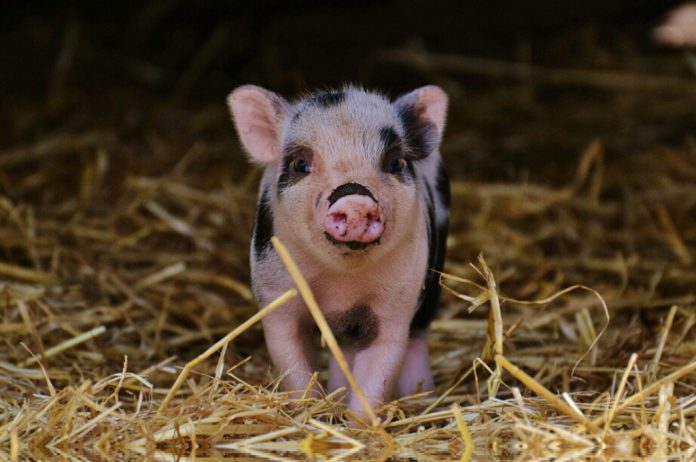DES MOINES, Iowa — The ongoing outbreaks of African swine fever (ASF) in China, Belgium and elsewhere, have crystallized the U.S. pork industry’s focus and collaboration on finding new ways to help protect the domestic herd from costly foreign animal diseases (FADs).
One new practice designed to reduce disease transmission risk involves knowing exactly how long certain feed ingredients have been securely stored before allowing their use on pig farms. As modelling in peer-reviewed research has made clear, it’s possible for swine disease viruses to survive in shipments of certain feed ingredients during transoceanic shipping to U.S. ports and even to inland points of feed manufacture.
Holding time
Based on this current research, a holding time of 78 days after the date of manufacture and bagging or sealing to prevent additional contamination (“born on date”) for amino acids, minerals or vitamins will degrade 99.99 percent of viral contamination.
The holding time extends to 286 days for soybean meal to allow for similar viral degradation, once shipped to prevent additional contamination.
“Working with your feed supplier to get this type of information is yet another way to help protect your pigs from potential infection from a foreign animal disease,” said Dave Pyburn, DVM, senior vice president of science and technology for the National Pork Board. “It’s just one more tool in our arsenal against African swine fever and other diseases that we hope will offer U.S. producers more protection against this growing global threat.”
Feeds studied
The feedstuffs studied that have shown the potential to support virus survival include: conventional soybean meal1, DDGS1, lysine hydrochloride1, choline chloride1, vitamin D1, pork sausage casings1, dry and moist dog food1, organic soybean meal1, soy oil cake1, moist cat food1, and porcine-based ingredients2.
There may be other feedstuffs that were not tested that could support survival of pathogenic viruses. Scientific study and proof-of-concept work in this area continues.
To date, without an organized surveillance program, pathogenic swine viruses are not being identified in imported feedstuffs.
“It’s clear from the research that certain feed ingredients can support viral survival during conditions modeled after either trans-Atlantic or trans-Pacific shipping to U.S. ports,” said Paul Sundberg, DVM, director of the Swine Health Information Center. “Based on these findings, we think it’s prudent that the entire U.S. pork industry look at this research and consider taking action to help us prevent a FAD from entering this country through this route.”
Key areas
In a related area of disease prevention, the National Pork Board, the National Pork Producers Council, the American Association of Swine Veterinarians and the Swine Health Information Center recommend that producers talk to their feed suppliers to get information about seven key areas.
- Describe the facility’s biosecurity program to minimize the spread of pathogens from people, vehicles and ingredients.
- Describe the facility’s employee training on feed safety.
- Describe the facility’s pest control program.
- Describe the facility’s traceability program.
- Describe the facility’s supplier approval program.
- Is the facility certified by a third-party certification body for food safety? Third-party certification programs may include the Feed Additives Manufacturers (FAMI-QS), the International Organization for Standardization (ISO), the Safe Quality Food (SQF), Safe Feed/Safe Food, etc.
- Does the facility utilize ingredients that were manufactured or packaged outside of the United States?
Decision matrix
To get a better handle on your particular farm’s risk of FAD transport via a feed ingredient, Sundberg advises producers to use the newly developed virus transport in feed ingredients decision tree matrix.
“It was developed to help producers work with their feed suppliers to minimize risk from feed ingredients,” he said.
Aside from the specific feed-related ways reduce disease risk, Tom Burkgren, DVM, executive director for the AASV, advises producers to review their current on-farm biosecurity plan with their veterinarian.
“While this is always a good thing to do periodically, it’s critically important now to find any potential weaknesses in your production practices so that you can take immediate steps to fix them to help protect your animals.”
The four swine groups continue to collectively reach out to USDA officials, including Chief Veterinary Officer Jack Shere, to see what can be done to enhance the protection of the domestic swine herd from ASF and all FADs.
“U.S. agriculture must bolster its defenses against the spread of animal disease as we face heightened risk,” said Liz Wagstrom, chief veterinarian for the National Pork Producers Council. “These measures should include private-sector efforts like those that have informed this feed directive as well as publicly funded programs to guard against disease outbreaks that would immediately close export markets and threaten prosperity in rural America.”










